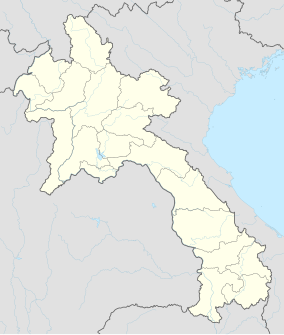Dong Hua Sao National Park
| Dong Hua Sao National Protected Area | |
|---|---|
IUCN category VI (protected area with sustainable use of natural resources) | |
| Location | Champasak Province, Laos |
| Nearest city | Pakse |
| Coordinates | 15°3′32″N 106°39′11″E / 15.05889°N 106.65306°E |
| Area | 1,100 km2 (420 sq mi) |
| Designated | 29 October 1993 |
Dong Hua Sao National Protected Area is a national protected area in Champasak Province in southern Laos. This forested park rises from the Mekong river lowlands eastwards into the Bolaven Plateau.[1] It is an ecotourism destination.[2]
Geography
Dong Hua Sao National Protected Area is located about 30 kilometres (20 mi) east of Pakse and about 10 kilometres (10 mi) south of the town of Paksong in Paksong, Pathoumphone and Bachiangchaleunsouk districts. The park's area is 1,100 square kilometres (420 sq mi) including 300 square kilometres (120 sq mi) of wetlands. Elevations range from 100 metres (300 ft) in the west to about 1,000 metres (3,300 ft) on the Bolaven Plateau.[1]
History
Coffee growing was introduced to this area in the 1940s. In 1950 the Dong Hua Sao Forest Reserve was declared, covering 260 square kilometres (100 sq mi). Wartime migration of ethnic minorities from highland to lowland areas took place in the 1960s and 1970s. In the 1980s there was extensive logging in the area, some to establish coffee plantations. In 1993 Dong Hua Sao National Reserved Forest was declared, later renamed to Dong Hua Sao National Protected Area, covering the current area of 1,100 square kilometres (420 sq mi).[1][3]
Flora and fauna
The park's main forest type is semidry evergreen forest. Upland forest is considered moist evergreen forest.[1]


Animal species include the endangered yellow-cheeked gibbon. Wild elephants once roamed the area, but now only domesticated ones are found. Bird life includes the grey-faced tit-babbler, found only in Indochina, and rare hornbills.[1][2] The wetlands are home to the Siamese crocodile, hog deer and green peafowl, all endangered.[3]
Threats
Dong Hua Sao faces a number of environmental threats. The most significant is forest conversion for coffee plantations. Other threats include destructive fishing practices, hunting, overcollection of forest products and use of wetlands for agriculture and fisheries.[1] The crocodiles of the wetlands face threats to their prey base from hunting and fishing.[3]
See also
References
- ^ a b c d e f "Dong Hua Sao". Greater Mekong Subregion Sustainable Tourism Development Project in Lao PDR. Archived from the original on 2 April 2015. Retrieved 12 March 2015.
- ^ a b "Dong Hua Sao NPA". Lonely Planet. Retrieved 12 March 2015.
- ^ a b c Claridge, Gordon (1996). "Dong Hua Sao Wetlands". An Inventory of Wetlands of the Lao P.D.R. International Union for Conservation of Nature. pp. 193–195. ISBN 978-2-8317-0319-0. Retrieved 12 March 2015.

